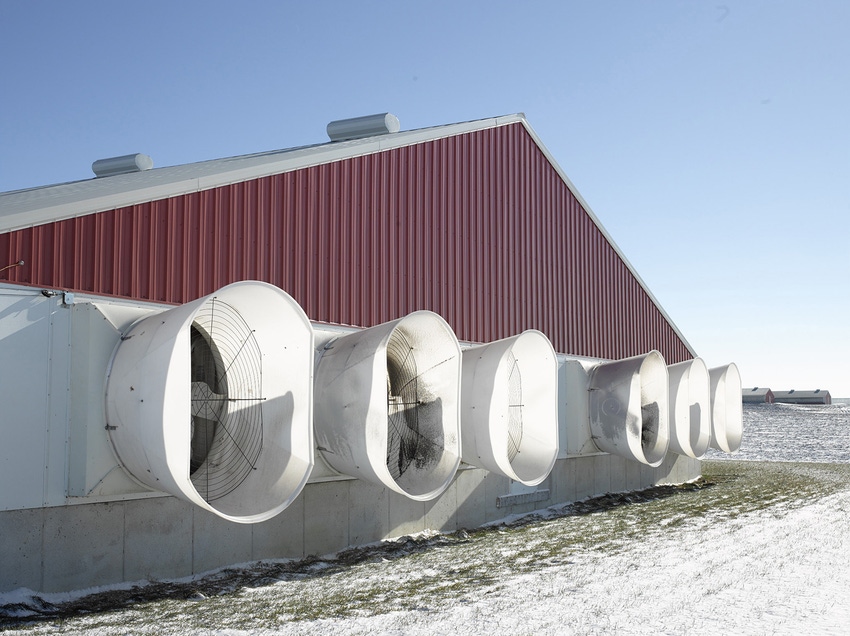To create a facility that performs at the level our pigs and producers desire, we must improve and unify ventilation design, construction integrity, control and monitoring.
December 19, 2018

By Brett C. Ramirez, Jay D. Harmon and Steven J. Hoff, Iowa State University Department of Agricultural and Biosystems Engineering
Earlier this month, the Iowa State University College of Agricultural and Life Sciences and College of Veterinary Medicine hosted a workshop on precision livestock farming. More than a dozen speakers shared experiences and perspectives on this rapidly growing field to advance animal health and welfare, improve meat quality, conserve natural resources and increase profits for producers. There were more than 100 attendees, including researchers and Extension specialists, animal production industry stakeholders and government agency personnel. Having a chance to reflect on this outstanding and insightful opportunity, I wanted to share some perspectives and highlights from my presentation.
The concept of “precision livestock farming” fully embodies the true nature of multi-/inter-disciplinary collaborations. No one discipline or just a subset of disciplines can solve the grand challenges impacting animal health, well-being and productivity. It truly requires every discipline to be in the conversation. Intensive animal production systems are in fact, just that, a system. Systems are comprised of connected things, parts, people, animals that form a complex whole. Therefore, a successful system must synergistically utilize the knowledge from all of its connected components, which are bi-directionally connected. This includes nutrition, health, management, genetics, engineering, construction, economics, ethology, etc. More often than not, the approach to solving some of the grand challenges are only met with pieces of this system. Advancement of our animal production systems needs the unity of multi-disciplinary collaborations to address each and every challenge.
From a ventilation perspective, we have not yet reached our highest level. The indoor environment (which is provided by and controlled by the ventilation system) can help ensure that the advancements made in nutrition, genetics, animal health, etc., are not marginalized. Engineers can use the ventilation system to help supplement those advances, if they are allowed to perform their role in collaboration with nutritionists, veterinarians, well-being specialists, etc. While there are novel ventilation technologies, equipment and designs constantly under development to help boost the performance of our facilities, rarely do all these components exist together in harmony. Thus, the frequent result is poor performing facilities. Most of these facilities often share many similar problems and this has also allowed for complacency with our ventilation systems. There is a noticeable gap between ventilation system design, construction integrity, technology in controllers and data management — and this gap continues to grow.
How does animal monitoring technology through PLF fit into this concept? We monitor animal behavior, health, etc., to learn and make improved management decisions. But, what if the facility doesn’t have the capacity to make changes? For example, camera technology can reliably detect the laying pattern (huddling versus separated) of pigs to determine if they are too warm or too cold. This is great technology and can really improve management by sending numerous alerts/notifications to caretakers or supervisors. Now, maybe this technology in the future could directly control the ventilation system. Again, this could be exceptional, but if the equipment and design of the system cannot actually perform because it was so poorly designed, constructed and installed … what good is the technology?
Another example, a sound/behavior monitor can detect the early onset of a potential health challenge. This is great technology that could really benefit the industry, but consider this, a health challenge is detected every single late-autumn for five years in a row — consistent bad flow of pigs? A bug left in the barn? Poor management? Maybe, but most likely not. However, the environment is quite poor (gassy, stagnant), there are drafts from poorly designed inlets dropping cold air on the pigs and room is so leaky that no static pressure can be developed. A strong connection between design, construction and operation must exist — with each complementing the other to provide the best environment possible for pigs.
If any aspect of the whole ventilation system (from design to operation) is incorrect or inadequate, it becomes nearly impossible to house the animals in a high-performance facility. Engineers must be allowed to perform their role, in collaboration with nutritionists, veterinarians, well-being specialists, etc., in helping to create high-performance, sustainable and economic swine production systems.
To create a facility that performs at the level our pigs and producers desire, we must improve and unify ventilation design, construction integrity, control and monitoring. The disconnect between building ventilation and the advancements in nutrition, genetics, animal health, etc., needs to be resolved. A more inter-disciplinary approach that includes high-performance facilities will be needed for the future.
Presentations of the invited speakers or more information from this PLF workshop at ISU are available upon request by emailing [email protected] or [email protected].
You May Also Like



